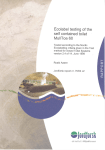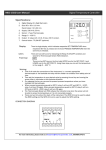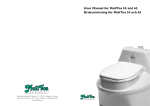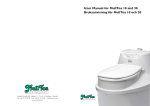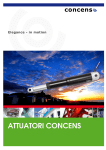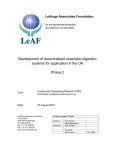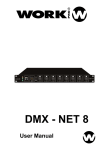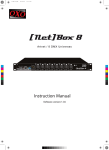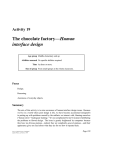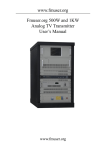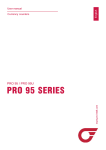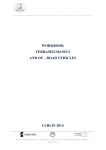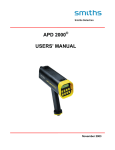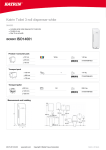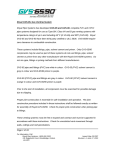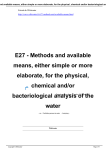Download Ecolabel testing of MullToa Komfort XL
Transcript
Ecolabel testing of MullToa Komfort XL RAPPORT Roald Aasen Jordforsk report nr 70/04 Ecolabel testing of the self contained toilet MullToa Komfort XL Tested according to the Nordic Ecolabelling criteria given in the Test method for closed Toilet Systems version 2.4 of 4.juni 1999 Roald Aasen Jordforsk report nr. 70/04 Preface This report presents the results of testing the self contained toilet model MullToa Komfort XL from Swedish Ecology AB, Gothenburg, Sweden, according to the criteria document from Nordic Ecolabelling version 2.4. Swedish Ecology AB has ordered and paid for the test. The Nordic Ecolabelling was established in 1989 by the Nordic Council of Ministers as a voluntary ecological labeling. This ecolabelling follows the IOS 14024 standard: “Environmental labels and declarations – Type 1 ecolabelling – Principles and Procedures”. The testing of materials and design has been done by Norwegian Centre for Soil and Environmental Research (Jordforsk), Ås in June 2003. The function testing has been done in climate cambers at the Centre for Plant Research in Controlled Climate at the Agricultural University of Norway in Ås during the spring of 2004. 70-04.doc Jordforsk report 70-2004 Side 2 Content Summary........................................................................................................................... 5 1. Introduction............................................................................................................... 6 2. Part I. Materials and construction ............................................................................. 7 2.1. Content of test model set .................................................................................. 7 2.2. Location and installation of test toilet (2.1)...................................................... 7 2.3. The design of the toilet (4.1)............................................................................. 7 2.4. Leakage (3.1 & 4.2) .......................................................................................... 8 2.5. Impact resistance (3.2 & 4.3)............................................................................ 8 2.6. Flammability (3.3 & 4.5) .................................................................................. 8 2.7. Deformation (3.4 & 4.4) ................................................................................... 8 2.8. Mechanical components (3.6 & 4.7)................................................................. 9 2.9. Drainage (4.8) ................................................................................................. 10 2.10. Electrical components (4.9) ........................................................................ 10 2.11. Ventilation from the toilet (4.10)................................................................ 10 2.12. Inspection possibility (4.11) ....................................................................... 10 2.13. Evaluation (4.12) ........................................................................................ 10 3. Part II. Function testing (5)..................................................................................... 11 3.1. Preconditions for function testing in a laboratory (5.1).................................. 11 3.1.1. Duration of test (5.1.1)............................................................................ 11 3.1.2. Test climate (5.1.2) ................................................................................. 11 3.1.3. Raw materials in compost (5.1.3 & 5.2.1) .............................................. 11 3.2. Performance of the test (5.2)........................................................................... 11 3.2.1. Procedure for filling (5.13 & 5.14) ......................................................... 11 3.2.2. Measurements of surplus fluid (5.2.4) .................................................... 12 3.3. Requirements as to functions (6) .................................................................... 12 3.3.1. Capacity (5.2.3 & 6.1) ............................................................................ 12 3.3.2. End product (5.5 & 6.2) .......................................................................... 13 3.4. Assessments (6.3) ........................................................................................... 14 3.5. Requirements to user manual (7) .................................................................... 14 4. Conclusions............................................................................................................. 15 5. Appendices.............................................................................................................. 16 70-04.doc Jordforsk report 70-2004 Side 3 Summary The self contained toilet MullToa Komfort Xl has been tested and evaluated to find out if the requirements for ecological labeling after the Nordic Ecolabel “Svanen” are meet. The testing was according to the criteria given in the Test method for closed Toilet Systems version 2.4 of 4.juni 1999 from Nordic Ecolabelling and preformed at Jordforsk research facilities at Ås in 2003 and in climate cambers at the Centre for Plant Research in Controlled Climate at the Agricultural University of Norway in Ås in the spring of 2004. The toilet meets the requirements for material and construction. The toilet meets the requirements for function testing for four population equivalents (p.e) when the compost is matured in an external emptying tray. For continuous use the toilet must therefore be equipped with two emptying trays. The instructions for use also meet the given requirements. The toilet meets all the requirements for Nordic ecolabelling and we therefore recommend the manufacturer to apply for approval for Nordic ecological Svane label. 70-04.doc Jordforsk report 70-2004 Side 4 1. Introduction The Nordic Ecolabelling was established in 1989 by the Nordic Council of Ministers as a voluntary ecological labeling. This ecolabelling follows the IOS 14024 standard: “Environmental labels and declarations – Type 1 ecolabelling – Principles and Procedures”. The objective of ecolabelling is to provide information to consumers that enable them to select products that are the least harmful to the environment. Ecological labelling is intended to stimulate environmental concern in product development and a sustainable society. The test criteria are chosen so that the environmental impacts during the life cycle of the actual product can be evaluated. The definition given in the criteria document of a closed (self contained) toilet system as is “a toilet that is not connected to a drainage system for retrieving faeces and urine”. The end product should be utilized as a means of soil improvement. The toilet can have an electrical supply up to 320 V. It is in principally toilet system based on biodegradation processes that will satisfy the requirements. The testing has to be done by an independent organization. The testing of MullToa Komfort XL was ordered and paid for by the producer Swedish Ecology AB and the testing and evaluation was done by Norwegian Centre for Soil and Environmental Research (Jordforsk) The self contained models from Swedish Ecology AB have been approved by the National Sanitation Foundation (N.S.F.) in the United States of America. The MullToa Komfort XL is the largest compact floor model available from this producer. 70-04.doc Jordforsk report 70-2004 Side 5 2. Part I. Materials and construction Paragraph numbers in the parenthesis i.e. (3.1 & 4.2) corresponds to test methods and the requirements in the test criteria document. 2.1. Content of test model set A complete set of the toilet and an installation kit was delivered by the manufacturer. The shipment consisted of two cardboard boxes. The largest box contained the MullToa Komfort XL toilet with serial number A NR. 66242, a metal rake, a plastic bag with a metal frame with nuts that fits the front cover for emptying, a 20 liter bag of peat moss labeled MullToa Special Mull and instructions for installation and use. The installation kit contained four 1,1 m long plastic pipes for ventilation, isolation material and outer pipe for the ventilation section above the roof, rubber flashing and a cap for sealing the ventilation pipe through the roof and a metal netting to be placed on top of the ventilation pipe. 2.2. Location and installation of test toilet (2.1) Testing of the materials and construction of the toilet was done in a laboratory at Jordforsk. The toilet was placed on a bench. A ventilation duct was connected to the air exhaust for the duration test (3.6 in original Norwegian version, missing in English version) and adjusted so that the airflow was slightly higher than the exhaust from the toilet. Room temperature during the duration test was around 20°C and air humidity was from 25 to 35 % RH. The testing of function was done in climate cambers at the Centre for Plant Research in Controlled Climate at the Agricultural University of Norway. A special rig was constructed for this test. The rig included a working platform for the toilet, a urinator and a control panel with timer for dosing of urine and control of the toilet stirrer. The room temperature was set to 18°C and air humidity to 55 % RH. The temperature and humidity were constant monitored and logged (Appendix 1). 2.3. The design of the toilet (4.1) The tested toilet meets the design requirements in paragraph 4.1 by having no sharp edges or projections that can cause injury to the user or to service personnel. This toilet is a compact model to be placed directly on the floor. It does therefore not have a pipe between the toilet bowl and the container for composting the waste. The opening below the seat ring is elliptic with 13,5 cm as the smallest diameter and 25 cm as the largest diameter. The toilet is equipped with a mechanical mixer with two arms. The mixer will not be activated as long as the toilet is being used or the toilet seat is raised to an open position. The toilet is also equipped with two shutters that do not open until the toilet seat ring is pressed down as done when seated. The shutters also blocks insight to the upper composting chamber. The electrical equipment and connections are hidden under the cover of the toilet. The cover is not accessible for users unless four screws are removed and the cover is lifted of. There is no warning lights or signal in case of electrical faults. The user instruction gives a description 70-04.doc Jordforsk report 70-2004 Side 6 of how to detect electrical and mechanical malfunctions. The test showed that this description works. The motor for the mixer and the ventilation fan gives a distinctive sound and the absence of these sounds indicates malfunctions. The detection of malfunction on the bottom heating element will not be detected before the fluid level starts to rise and becomes visible in the transparent tubes connected to the emptying tray. The ventilation pipe is equipped with metal netting on top of the pipe outside. The grid size prevents rodents and larger insects to enter the ventilation and get access to the toilet from the outside. The toilet lid also prevents rodents from getting access to the waste from the toilet room. An addition lid with gasket is put in the toilet opening when the toilet is not used for longer periods. The safety for children is considered to be sufficient. Smaller children form age 1-4 years should in any case be accompanied by adult persons when using the toilet because they can gain access to the waste by their hands. The risk of getting clenched between the stirrer and the fixed arm is considered to be small because the fixed arm is placed away from the opening. The mixer also moves very slowly. Conclusion: The toilet meets the requirements in paragraph 4.1. 2.4. Leakage (3.1 & 4.2) The toilet was tested for leakage by filling it with water. There was no leakage until the water level reached the fixed arm. When the water level continued to raise further the pressure on the front cover became too great and water started to leak past the gasket. However this level is far above the waste and fluid level when the toilet is used correctly. There was no leakage after the function test was completed. Conclusion: The toilet meets the requirements in paragraph 3.1. 2.5. Impact resistance (3.2 & 4.3) The test was done as described in 3.2. The toilet was hit twice on the backside and twice on the side. The test was also repeated after the function test. There was no visible damage, marks or cracks on the outside after impact. Conclusion: The toilet meets the requirements in paragraph 4.3. 2.6. Flammability (3.3 & 4.5) The test was done as described in 3.3. The toilet seat ring and lid was assumed to be the most inflammable parts of the toilet. The outside of the toilet was also tested. None of these parts did ignite Conclusion: The toilet meets the requirements in paragraph 4.5 2.7. Deformation (3.4 & 4.4) The test was done as described in 3.4. The height from floor to the toilet seat ring base was measured in level position before tree plastic boxes filled with water and weighing 150 kg 70-04.doc Jordforsk report 70-2004 Side 7 were placed on top of this. The deformation was measured and found to be 4-6 mm. This is within the accepted limit of < 10 mm deflection. Conclusion: The toilet meets the requirements in paragraph 4.4. 2.8. Mechanical components (3.6 & 4.7) The test was done as described in 3.6 in the original Norwegian version (3.5 in English version). Filling of toilet with waste: The described procedure form the manufacture for starting up the toilet was followed. 2/3 of a 20 liter bag of MullToa Special Mull was filled into the upper composting compartment with the hatch open down to the lower composting compartment. The hatch was then closed and 10,5 kg dewatered sewage sludge with a dry weight of 20 % was added in small portions together with 82 g toilet paper and 4 liter water to moisten the paper. This represents 52 population equivalents (p.e.) sludge but only 10 p.e. in paper. The amount of paper was reduced because it was difficult to mix that much paper with the sludge. In ordinary testing the waste materials are added on a daily basis in smaller portions so that much of the toilet paper disintegrated before the next addition. The amount of spread of peat moss mix followed the recommendations given in the user manual with 2 liter spread per week for 4 p.e. Total waste added resulted in 10-12 cm filling in the upper compartment. Measurement of torque on mixer: After the mixer had run for a couple of hours, the torque was measured after motor and gear were removed. A spring balance was attached to the stirrer 28 cm from center and the pull was measured 90° on rotation direction in a close to level position. The torque was around 16,5 Nm when passing the fixed arm and 11-12,5 Nm elsewhere in the circle. The torque without any waste was measured to at least 38,5 Nm (maximum load on the spring balance). The toilet therefore meets the requirement of at least 50 % higher torque than maximum load. Measurement of maximum use of electrical power: The amount of electrical power used was measured when the stirrer was running and with the regulator knob in position 10 so that all electrical components were in use: ventilation fan, heating elements by fan and in bottom of toilet and stirrer motor. The electrical current was measured to 1,4 A and the voltage to 218 V resulting in a use of 305,2 W. This is with in the limit of 320 W. Testing wear on stirrer, motor and gear: The stirrer was run continually with waste in the toilet for 34 days by bypassing the start and stop mechanism. After running the test for 28 days the amount of waste was reduced to ca. 5 cm filling height and transformed into small spheres. A new load of 15,5 kg dewatered slurry, 136,5 g toilet paper and 7 liter water were added in small portions. The new height of waste was then 11-13 cm in the upper compartment and 7-10 cm on day 34. Testing start and stop on mixer: To simulate 5 years of use by 4 p.e. each using the toilet 5 times a day (36.500 visits) a new start and stop timer and counter was connected and programmed to give 2 s stops and 3 s runs. After 5 days the mixer had completed 96.230 cycles of stops and runs. There were no toilet paper visible in the waste after 5 days and the waste was 8 cm deep in the upper compartment. 70-04.doc Jordforsk report 70-2004 Side 8 After the start and stop test the waste was removed and the toilet washed and inspected for damage. No visible damage on mixer, gear and motor or wires were detected. There was no increase in rim movement on the mixer axel and bearings after the test. Conclusion: The toilet meets the requirements in paragraph 4.7. 2.9. Drainage (4.8) Liquid can not leak from the toilet if the front cover is properly tightened and only opened when there is no liquid to be seen in the indicator tubes. Measurements against raising fluid levels are described in the user instructions. This includes raising the heat on the thermostat. The tube for indicating liquid in the lower compartment can also be disconnected and serve as an emergency overflow draining option. It is also possible to install a permanent overflow tube from the back of the toilet by boring a hole in a prefabricate depression in the toilet. Conclusion: The toilet meets the requirements in paragraph 4.8. 2.10. Electrical components (4.9) The electrical components are approved by SEMKO. Conclusion: The toilet meets the requirements in paragraph 4.9. 2.11. Ventilation from the toilet (4.10) The ventilation fan has no grid on this toilet. Brown dust was observed around the fan after the duration test of the mixer. The dust was easily removed by brushing. There was no annoying noise or vibrations from the fan or motor and gear. Conclusion: The toilet meets the requirements in paragraph 4.10. 2.12. Inspection possibility (4.11) The lower composting chamber can be inspected from the front cover. The upper composting camber can be inspected through the toilet seat when the shutters are kept open. The upper compartment, fan, electrical components and motor and gear can also be inspected when the upper housing is removed. This is done by unscrewing four screws, a ring around the button for starting the mixer, lift of the thermostat button and then remove the upper part. Conclusion: The toilet meets the requirements in paragraph 4.11. 2.13. Evaluation (4.12) The testing according to the criteria documents has shown that the toilet fulfills all the requirements of 4.1-4.12 with regards to materials and construction. Conclusion: The toilet meets the requirements in paragraph 4.12. 70-04.doc Jordforsk report 70-2004 Side 9 3. Part II. Function testing (5) 3.1. Preconditions for function testing in a laboratory (5.1) 3.1.1. Duration of test (5.1.1) The toilet was filled during an 8 week period starting 27. January 2004 and lasting until 24. March 2004. The composting period started 24. March 2004 and lasted for 12 weeks until 16. August 2004. 3.1.2. Test climate (5.1.2) The toilet was tested in controlled climatic rooms at the Centre for Plant Research in Controlled Climate, The Agricultural University of Norway, Ås. The air temperature and relative humidity (RH) were monitored and logged every hour. The temperature was set to 18°C and RH to 55 % during the filling period (Appendix 1). During the composting period the temperature was set to 9°C (Appendix 2). 3.1.3. Raw materials in compost (5.1.3 & 5.2.1) Sewage slurry: Day fresh dehydrated sewage slurry from Skipphelle sewage treatment plant in the Follo municipality, Norway, was used in the test and stored dark in plastic boxes at 4°C. Aluminum based chemicals were used for sedimentation of the slurry. The dry weight (DW) content in the slurry was 24 %. The pH value was 6.5. The average number of thermotolerant coliform bacteria (TCB) from three samples was 44000 TCB/ g DW (65000, 2417 and 65000 TCB/g DW, Appendix 3). The second sample from 29th of January was sampled on a Thursday but not analyzed before Monday. This may explained why the TCB count was lower than in the two other samples. The TCB in the slurry was therefore considered sufficient high enough to use the slurry itself as a TCB indicator without adding bags of TCB to test the reduction rate in the mature compost. Urine: Urine was prepared from chemicals from Merck, Damstadt, Germany and mixed as described. Toilet paper: Green Viking Toalettpapir, Hydro consum, Hydro Hagebruk Product, Royal Lotus toilet paper from Georgia-Pacific Finland Oy, Nokia Finland and Lambi toilet paper from Metsä Tissue AB, Sweden were used in the test. 3.2. Performance of the test (5.2) 3.2.1. Procedure for filling (5.13 & 5.14) The procedure from the manufacturer was followed during startup. Two thirds of a 20 l bag of MullToa Spesial Mull was added with the damper open. Raw materials equalents to 4 p.e. were added to the toilet as described in 5.13 and 5.1.4. A urinator dosed urine 16 times a day once every hour starting from 8 a.m. to 12 midnight. The sludge and toilet paper were added once a day between 9 a.m. to 2 p.m. from Monday to Friday. The solid waste for Saturday and Sunday was added on Monday or on Friday. 70-04.doc Jordforsk report 70-2004 Side 10 The sludge was taken from the cooling room and weighed and added in three portions between layers of toilet paper. The paper was moistening by tap water. Toilet paper that was left on top of the compost surface the next day was pushed into the compost by the supplied compost rake. Additional strew was added at 0.5 liters per week per person if needed according to the user manual. 3.2.2. Measurements of surplus fluid (5.2.4) The toilet was equipped with an extra drainage to an external tank in case of surplus fluids. The hose was fixed to the side of the lower compartment to catch fluids that overfills the emptying tray. 3.3. Requirements as to functions (6) 3.3.1. Capacity (5.2.3 & 6.1) The capacity for handling solid waste for this toilet is limited by that the filling level in the upper compartment must not be higher than the upper stirrer arm and that the requirements of maturated compost must be met before the next tray can be emptied. The capacity for handling liquids defined so that the lower compartment must be dry without any fluid when the emptying tray needs to be removed. The lower compartment will only be flooded if the emptying tray is overfilled. The toilet was loaded with urine, slurry and toilet paper equivalent to 4 p.e. for 8 weeks according to 5.1.4. The toilet was able to handle all loads without overfilling. The waste level was never higher than up to the upper stirrer. This is the maximum filling level described in the user manual. If this level is exceeded the emptying tray must be emptied. Peak loads of urine in week 4 and 8 caused minor overflows (3.5 and 0.9 l) of the emptying tray into the external test tank the next day. The surplus fluid was added to the waste again through the toilet seat and did not cause any new overflowing. All the extra urine (5170+4890 and 5100 g) was added in manually in portions of 5 kg in less than 5-10 minutes witch is a quite heavy load over such a sort time for a compact model like this. In real use it is likely that this load is spread over a much longer time during a day. It is also likely that the amount is delivered in portions from 250 to 400 ml witch results in 12 to 20 single visits to the toilet. The amount of fluids ventilated from the toilet was also measured directly in the outlet air by measuring the air flow, the air temperature and the humidity. Measure on February 23. the RH was 75.5 %, air temperature 19.2°C and the airflow 25 m3 standard pressure/hour witch is equalents to aproximal 5100 g fluids pr day. This reading was done only once without any calibration of the equipment. The evaporation may be higher than measured because there was no major fluid accumulation in the toilet. The toilet is designed to operate in heated toilet rooms at 18-22°C with normally have a much lower air humidity. This will increase the toilets evaporation capacity under normal operations. Also, if the toilet is left unused for a day or two with maximal heating on the compost in the emptying tray will rapidly dry up. This was shown in additional testing after the first loading period of 8 weeks was completed. The toilet is designed to handle extra fluid in the lower compartment outside the emptying tray. A procedure for this is described in the user manual. Extra strew (4.9 kg) within the 70-04.doc Jordforsk report 70-2004 Side 11 amount described in the user manual was also added after the top loads in order to make the compost more porous. Conclusion: The toilet meets the requirements in paragraph 6.1. for continuous use up to 4 p.e. when the compost can be matured in an external emptying tray. For continuous use the toilet must therefore be equipped with two emptying trays. There is no need for an extra emptying tray if the toilet is used up to 8 weeks continuously in vacation homes or cabins by 4 p.e. and the toilet is left unused for a period up to two months. 3.3.2. End product (5.5 & 6.2) Dry weight (5.5.1 & 6.2.1) The dry weight of the compost from the emptying tray was measured after 17 and 22 weeks of maturation in 9°C climate room. The dry weight (DW) was not measured when the emptying tray was removed after the loading period ended, but because the extra urine that was added 5 days earlier the compost was still very wet and at least as wet as the sludge at 24 % DW. After 17 weeks the DW in the compost was 34.1 % and after 22 week 42.7±0.5 % (Appendix 4). This gives a reduction in DW of 36.4 % after 17 weeks and 70.8 % after 22 weeks of maturation and the compost therefore meets the requirements of a 25 % reduction in DW. Conclusion: The toilet meets the requirements in paragraph 6.2.1. Thermotolerant coliform bacteria (TCB) (5.5.2 & 6.2.2) The number of TCB in the compost from the emptying tray was measured after 11 and 22 weeks of maturation in 9°C controlled climate room. Because of the selected dilution series the number of TCB after 11 week could not be determined any closer than < 20 TCB/ g. After 22 weeks the number of TCB were <2 TCB/g wet weight (Appendix 5). The TCB number may already have been sufficiently low after 11 week or earlier, but this could only have been shown by earlier samples and precise analyses. Conclusion: The toilet meets the requirements in paragraph 6.2.2. pH (5.5.3. & 6.2.3) The pH of in the compost from the emptying tray was measured after 22 weeks of maturation in 9°C climate room. The pH was 7.7±0.1 (Appendix 4). Conclusion: The toilet meets the requirements in paragraph 6.2.3. Nitrogen content (5.5.4 & 6.2.4) The content of Kjeldahl nitrogen in the compost from the emptying tray was measured after 17 weeks of maturation in 9°C climate room. The content was 3.27 g/ 100 g DW (3.27 %) (Appendix 6). Conclusion: The toilet meets the requirements in paragraph 6.2.4. Odor (5.5.5 & 6.2.5) There was no odor in the testing room were the toilet was installed. 70-04.doc Jordforsk report 70-2004 Side 12 There was a faint smell of toilet waste from the compost after 22 weeks of maturation in 9°C climate room. There was no smell of ammonia or urine, no sulphide decomposition and no acidic smell from the compost. Conclusion: The toilet meets the requirements in paragraph 6.2.5 Consistency (5.5.6 & 6.2.6) The compost consistency from the emptying tray was measured after 22 weeks of maturation in 9°C climate room. The consistency was firm and the structure was more like crumbling cheese. Conclusion: The toilet meets the requirements in paragraph 6.2.6. 3.4. Assessments (6.3) The toilet meets the requirements to capacity with the additions stated in the conclusion in capter 3.3.1. and the requirements for dry solid and TCB content in the end product. The end product also meets the requirements as regards to nitrogen, pH and consistency. The odor was not like any odor characterized in the requirements. The odor was not annoying. Conclusion: The toilet meets the requirements in paragraph 6.3. 3.5. Requirements to user manual (7) The revised instruction for use meets the requirements in paragraph 7.1, assembly instructions in 7.2 and installation instructions in 7.3. 70-04.doc Jordforsk report 70-2004 Side 13 4. Conclusions The MullToa Komfort XL model meets the requirements given in the Test Method for Closed Toilet Systems of June 14. 1999. document when equipped with an extra emptying tray for external compost maturation. 70-04.doc Jordforsk report 70-2004 Side 14 5. Appendices Overview appendix Nr subject 1 Temperature and relative humidity (RH %) in climate room for function testing 2 Temperature and relative humidity (RH %) in climate room for compost maturation 3 Thermotolerant Coliform Bacteria (TCB) in sludge 4 Dry Weight (% DW) and pH in mature compost 5 TCB in mature compost 6 Nitrogen (N) Kjeldahl in mature compost 70-04.doc Jordforsk report 70-2004 Side 15 Appendix 1: Temperature and relative humidity (RH %) in climate room for function testing 70-04.doc Jordforsk report 70-2004 Side 1 Room temperature °C % RH Temperature °C Temperature and relative humidity RH 20,0 70 19,5 68 19,0 66 18,5 64 18,0 62 17,5 60 17,0 58 16,5 56 16,0 54 15,5 52 15,0 0 200 400 600 800 Hours 1000 1200 50 1400 Appendix 2: Temperature and relative humidity (RH %) in climate room for compost maturation 70-04.doc Jordforsk report 70-2004 Side 2 Room temperature °C % RH Temperature and relative humidity RH 11,0 100 10,5 95 10,0 90 Temperature °C 9,5 9,0 85 8,5 80 8,0 75 7,5 7,0 0 200 400 600 800 Hours 1000 1200 70 1400 Appendix 3: Thermotolerant Coliform Bacteria (TCB) in sludge 70-04.doc Jordforsk report 70-2004 Side 3 Appendix 4: Dry Weight (% DW) and pH in mature compost 70-04.doc Jordforsk report 70-2004 Side 4 Appendix 5: TCB in mature compost 70-04.doc Jordforsk report 70-2004 Side 5 Appendix 6: Nitrogen (N) Kjeldahl in mature compost Sample no. 2. 70-04.doc Jordforsk report 70-2004 Side 6
































